 | ||||||||||||
|
|
Hey Stephanie! Thanks SO much for your kickass website - I've followed a ton of your recipes and I dig your good taste and enthusiasm you take everything on with. I have a question about the baby artichoke - you say peel down. The outer leaves? And then do you eat the whole thing? I blame my East Coast upbringing for my total lack of knowledge in the artichoke realm - but your idea makes them seem so much more accessible, I need to try. Thanks. Ginny
Dear Ginny, I totally didn't mean to be so oblique in my Trader Joe's post, but your question inspired me to photograph this demo (one-handed!). The short answer is, yes: you peel the outer leaves down to a certain color-coded level and then you are free and clear to eat the whole thing. Here is a visual primer to aid you in your preparations. (Please excuse my scarred fingers, I never claimed to be a hand model.) Step 1: Get yourself a hearty pile of baby artichokes. If you are in California, you can get them all the livelong year. Well, nearly. If you are elsewhere, you might need to wait until winter or late spring. Next, prepare yourself a bowl of acidulated water (scroll down to Step 9).
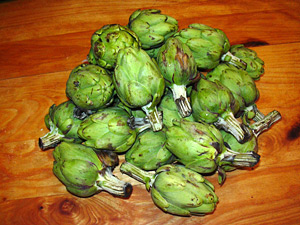 Step 2: Note the tightly closed leaves around this sucker -- this is what you want. As the artichoke matures and starts noticing girls, the leaves spread and the tough problematic choke starts to develop in the middle. It is not poisonous, as my mother told me when I was a kid in order to keep me from sticking the furry bits in my mouth, but it is inedible and should be removed before cooking.
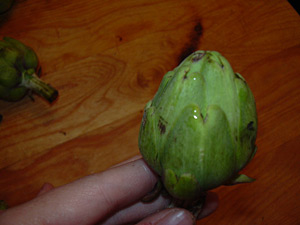 Step 3: Well, hello bonus protein! That's a worm hole with a camera-hogging worm all ready for his close-up. Unless your culinary life has been inspired by How to Eat Fried Worms -- and I'm not saying that book didn't make me hungry -- it's a very good idea to bin any artichokes that show evidence of worm habitation.
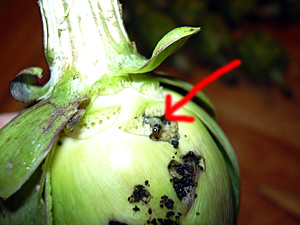 Step 4: The stems of artichokes are just as delectable as the artichokes themselves but their outer skin could benefit from a trim. Using a very sharp paring knife, carefully peel off the outer stem skin.
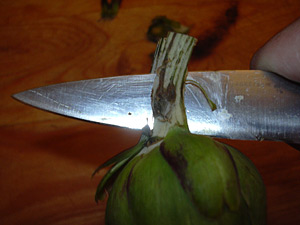 Step 5: This is what a clean stem looks like before it goes completely brown.
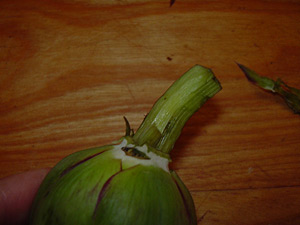 Step 6: Sometimes the artichoke stems are as bendy as those random carrots you forgot are still in your crisper drawer. If that's the case, cut them completely free from the rest of the choke. If you still see brown spots like this at the base of the artichoke, be like Oedipus and gouge it out.
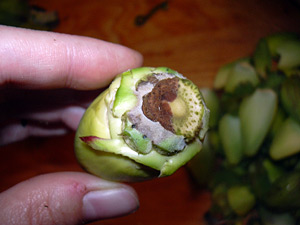 Step 7: You want to snap off all the outer leaves until you get down to the tender pale green/yellow leaves. When you reach this stage, you have peeled off enough leaves.
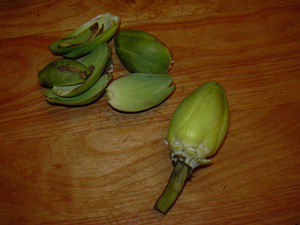 Step 8: Give the very top of the plucked artichoke a buzz cut and cut it in half lengthwise.
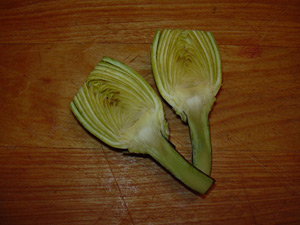 Step 9: Because artichokes start to brown the moment you cut them, toss your prepped babies into a bowl of acidulated water. That is, water that has lemon juice squeezed into it. Here's a tip I learned from Lidia Bastianich: if you don't have lemons, drop a vitamin C tablet into the water; it will dissolve and do the job just fine. The thing is, no matter how quickly I dump the prepped artichokes into their citric acid bath, some small amount of browning still occurs. However, I am usually able to prevent the artichokes from looking completely tanorexic.
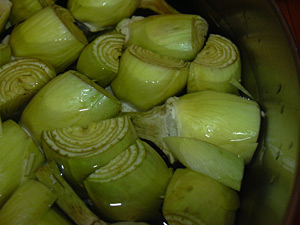 Step 10: Wash your hands. Raw artichokes are damn bitter, as you will quickly learn if you stick your fingers in your mouth, post prepping and sans washing. If you aren't in the habit of regularly sticking your fingers in your mouth as I seem to be, skip this step. Step 11: Cook.
| |||||
|
| |||||
|
|
|




